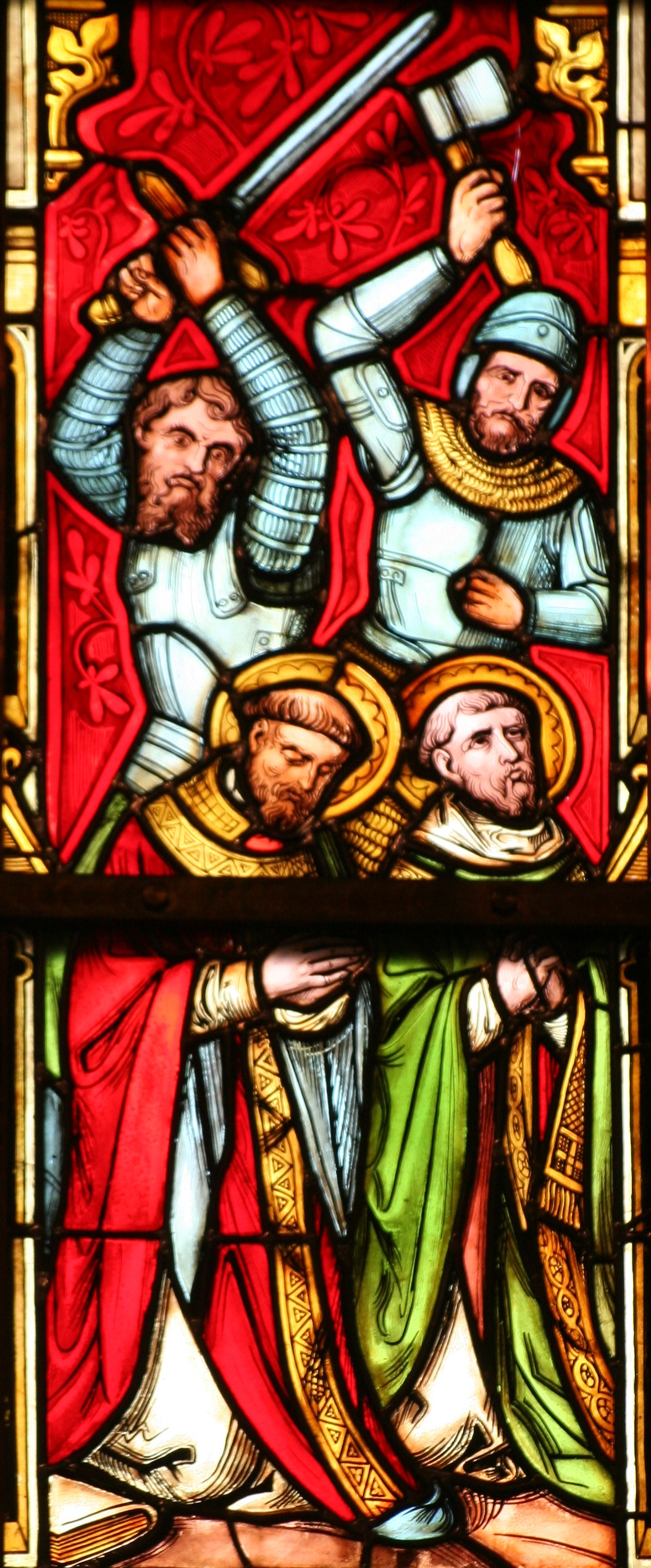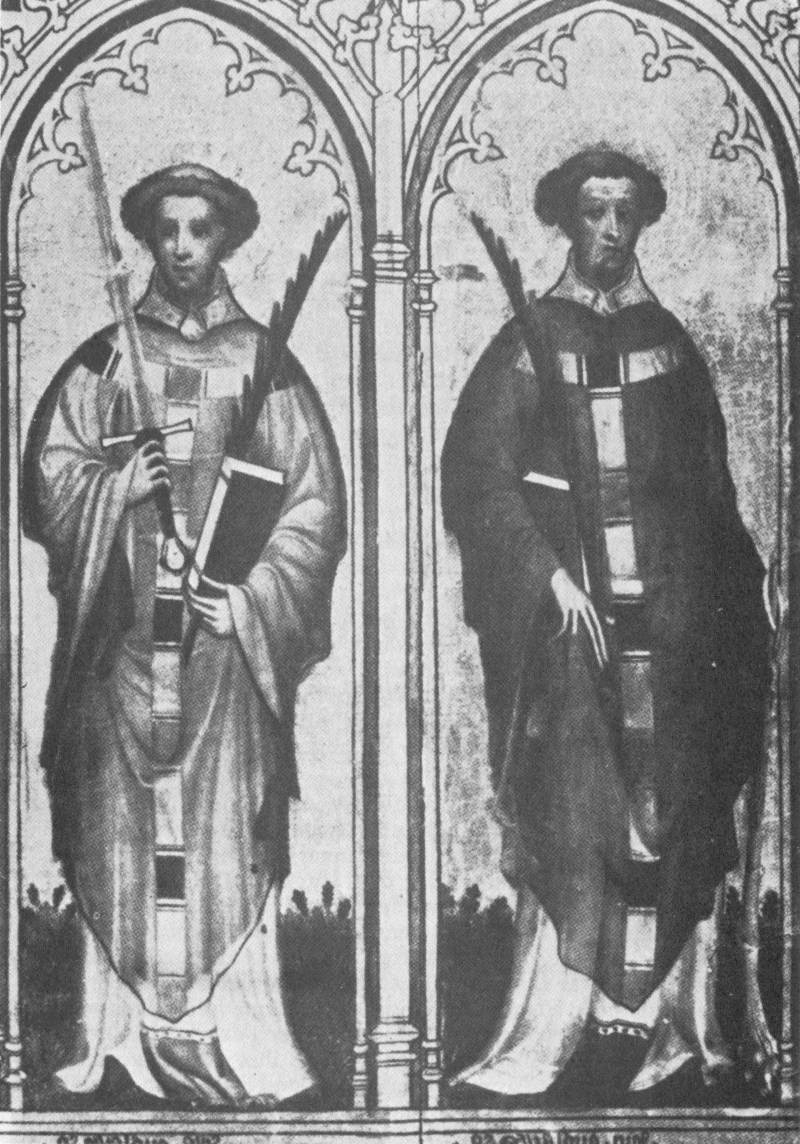Saint Ewald
Prêtre et martyr, bénédictin, disciple de Saint
Willibrord (✝ 695)
Martyrologe romain
SAINT EWALD LE BLOND ET SAINT EWALD LE BRUN, APÔTRES
DE LA WESTPHALIE
Saint Ewald le Blond et saint Ewald le Brun nés en Northumbrie (nord de
l’Angleterre) sont frères. Tous deux furent moines-prêtres en Irlande et
suivirent saint Willibrord quand il partit évangéliser les Frisons sur le
continent (Allemagne). Vers 690, ils le quittèrent pour porter l'évangile aux
Saxons. Ils rencontrèrent l'un de leurs chefs, mais les notables de la tribu
craignirent sa conversion au christianisme et la colère de leurs divinités. Ils
décidèrent donc que les Ewalds devaient mourir. Ewald le Blond fut passé par le
fil de l'épée, mais Ewald le Noir fut soumis à la torture, parce qu'il était le
porte-parole et montrait une fière résistance. Les deux frères furent mis à
mort, vraisemblablement à Anlerbeck en Westphalie. Leurs corps jetés dans le Rhin
flottèrent miraculeusement à contre-courant sur quarante miles dans une lumière
céleste. On dit qu’une fontaine jaillit au lieu de leur martyr. Les deux saints
Ewald sont honorés comme martyrs et saints patrons de la Westphalie.
Saint Ewald le Blond et saint Ewald le Brun sont fêtés le 3 octobre
SOURCE : http://www.eoc-coc.org/eglise-orthodoxe-celtique-accueil/saints-du-mois/octobre/saints-ewald/
Hl.Brüder Ewald aus Dorsten-Rhade (NRW, Deutschland)
Saint Ewald the Black
Also
known as
- Ewald
the Dark
- Hewald
Profile
Priest. Studied in Ireland. Knew Saint Willibrord of Echternach. Missionary to Saxony with Saint Ewald the Fair c.690. Tortured and murdered by pagan Saxons who feared to give up the old
religion. Martyr.
Born
- Northumbria, England
- torn limb from limb c.695 at
Aplerbeck, Westphalia
- body thrown into the
River Rhine, but they were miraculously moved 40 miles upstream to a place where friends were
camping, and then were recovered
- relics translated to the church of Saint Cunibert, Cologne, Germany by Duke Pepin of Austrasia
- some relics translated to the Premonstratensian monastery of Florennes in the province of Namur in 1121 by Saint Norbert
- most relics destroyed by Anabaptists in 1534
SOURCE :
https://catholicsaints.info/saint-ewald-the-black/
Saint Ewald the Fair
Also
known as
- Hewald
the Fair
Profile
Priest. Studied in Ireland. Knew Saint Willibrord of Echternach. Missionary to Saxony with Saint Ewald the Black c.690. Tortured and murdered by pagan Saxons who feared to give up the old
religion. Martyr.
Born
- Northumbria, England
- torn limb from limb c.695 at
Aplerbeck, Westphalia
- body thrown into the
River Rhine, but they were miraculously moved 40 miles upstream to a place where friends were
camping, and then were recovered
- relics translated to the church of Saint Cunibert, Cologne, Germany by Duke Pepin of Austrasia
- some relics translated to the Premonstratensian monastery of Florennes in the province of Namur in 1121 by Saint Norbert
- most relics destroyed by Anabaptists in 1534
Sts. Ewald
(Or HEWALD)
Martyrs in Old Saxony about 695. They were two priests and natives
of Northumbria, England.
Both bore the same name, but were distinguished as Ewald the Black and Ewald
the Fair, from the difference in the colour of their hair and complexions.
According to the example of many at that time, they spent several years as
students in the schools of Ireland. Ewald the Black
was the more learned of the two, but both were equally renowned for holiness of life.
They were apparently acquainted with St. Willibrord, the
Apostle of Friesland, and were animated with his zeal for the
conversion of the Germans.
Indeed, by some they have been actually numbered among the eleven companions of
that saint, but it is more probable they did not set out from England till after
St. Willibrord's departure. They entered upon their mission about 690. The
scene of their labours was the country of the ancient Saxons, now part of Westphalia, and covered
by the dioceses of
Münster, Osnabrück,
and Paderborn.
At first the Ewalds took up their abode in the house of the steward of a
certain Saxon earl or ealdormen (satrapa). Bede remarks that
"the old Saxons have no king, but they are governed by several ealdormen
[satrapas] who during war cast
lots for leadership, but who in time of peace are equal in power" (Hist.
Eccl., V, 10). The steward entertained his two guests for several days, and
promised to conduct them to the chieftain, as they affirmed they had a message
of considerable importance to deliver to him.
Meanwhile, the Ewalds omitted nothing of their
religious exercises. They prayed often,
recited the canonical
hours, and celebrated Mass, for they carried
with them all that was necessary for
the Holy Sacrifice.
The pagan Saxons,
understanding from these things that they had Christian priests and
missionaries in their midst, began to suspect that their aim was to convert
their over-lord, and thus destroy their temples and their
religion. Inflamed with jealousy and anger, they resolved
that the Ewalds should die. Ewald the Fair they quickly despatched with the
sword, but Ewald the Black they subjected to torture, because he was the
spokesman and showed greater boldness. He was torn limb from limb, after which
the two bodies were cast into the Rhine. This is understood to have happened on
3 October at a place called Aplerbeck, where a chapel still
stands.
When the ealdorman heard of what had been done he was
exceedingly angry, and took vengeance by ordering the murderers to be put to death and
their village to be destroyed by fire. Meanwhile the martyred bodies
were miraculously carried
against the stream up the Rhine, for the space of forty miles, to the place in
which the companions of the Ewalds were residing. As they floated along, a
heavenly light, like a column of fire, was seen to shine above them. Even the
murderers are said to have witnessed the miraculous brightness.
Moreover, one of the martyrs appeared
in vision to the monk Tilmon
(a companion of the Ewalds), and told him where the bodies would be found:
"that the spot would be there where he should see a pillar of light
reaching from earth to heaven". Tilmon
arose and found the bodies, and interred them with
the honours due to martyrs.
From that time onwards, the memory of the Ewalds was annually celebrated in
those parts. A spring of water is said to have gushed forth in the place of
the martyrdom.
Pepin, Duke of Austrasia, having heard of the wonders
that had occurred, caused the bodies to be translated to Cologne, where they were
solemnly enshrined in the collegiate church of St.
Cunibert. The heads of the martyrs were
bestowed on Frederick, Bishop of Münster, by Archbishop
Anno of Cologne, at the opening of the shrine in 1074. These relics were
probably destroyed by the Anabaptists in
1534. When St.
Norbert visited Cologne in 1121, he obtained two small vessels
containing the relics of
several saints,
and among them were bones of the sainted Ewalds. These were deposited either
at Prémontré, or
at Florennes, a Premonstratensian monastery in the
province of Namur.
The two Ewalds are honoured as
patrons in Westphalia,
and are mentioned in the Roman Martyrology on 3 October. Their feast is celebrated
in the dioceses of
Cologne and Münster.
Edmonds, Columba. "Sts. Ewald." The
Catholic Encyclopedia. Vol. 5. New York: Robert Appleton
Company, 1909. 25 Oct.
2020 <http://www.newadvent.org/cathen/05672a.htm>.
Transcription. This article was transcribed for
New Advent by Gerald M. Knight.
Ecclesiastical approbation. Nihil Obstat. May
1, 1909. Remy Lafort, Censor. Imprimatur. +John M. Farley, Archbishop
of New York.
Copyright © 2020 by Kevin Knight. Dedicated to the Immaculate Heart of Mary.
SOURCE : https://www.newadvent.org/cathen/05672a.htm
Мощевик священномучеников Светлого и Тёмного Эвальдов
в кёльнской церкви святого Куниберта.
Ewald Reliquien Schrein in St. Kunibert (Köln).
Sant' Ewaldo il Nero ed Ewaldo il
Bianco Monaci e martiri
Britannia, VII sec. - † Renania,
Germania, 3 ottobre 695
I santi con questo nome che vengono
ricordati oggi, in realtà, sono due: Edwaldo il Bianco ed Edwaldo il Nero,
patroni della Westfalia, così chiamati dal colore dei loro capelli. Di origini
anglosassoni, nacquero in Britannia nel VII secolo e seguirono nel 690 il loro
abate Willibrordo (657-739), che con undici monaci aveva intrapreso la sua
opera evangelizzatrice tra i Frisoni occidentali. Nel 695 Willibrordo li inviò
ad evangelizzare i Sassoni. Le loro intenzioni però non poterono attuarsi,
perché nello stesso 695, i due monaci subirono il martirio per mano di alcuni
fanatici, difensori delle loro tradizioni pagane e timorosi della propagazione
del cristianesimo fra il popolo sassone. Il martirio fu diverso per i due
monaci; Ewaldo il Bianco fu trafitto subito con la spada, mentre Ewaldo il Nero
fu invece torturato a lungo crudelmente e come narra lo storico anglosassone
Beda il Venerabile (672-735), gli assassini infierirono su di lui con orribili
mutilazioni; i resti dei due martiri furono gettati nel fiume Reno e ripescati
e sepolti poi, da un monaco di nome Tilmon. (Avvenire)
Martirologio Romano: In
Sassonia, nell’odierna Germania, due santi martiri di nome Evaldo, il primo
detto Nero, l’altro Bianco: sacerdoti di origine inglese, formati sull’esempio
di san Villibrordo e dei suoi compagni, passarono in Sassonia e, avendo
cominciato a predicare Cristo, catturati dai pagani, subirono il martirio.
La festa dei due santi monaci e martiri Ewaldo, venerati come patroni della Westfalia, viene comunemente celebrata il 3 ottobre, giorno del loro martirio, mentre nella diocesi di Colonia, essi sono festeggiati il 12 ottobre.
I due omonimi monaci, sono anche gli unici a portare questo nome, fra la variegata costellazione dei santi e beati del cattolicesimo.
Di origini anglosassoni, nacquero in Britannia nel VII secolo e seguirono nel 690 il loro abate s. Willibrordo (657-739), che con undici monaci aveva intrapreso la sua opera evangelizzatrice tra i Frisoni occidentali, (abitanti della Frisia, antica regione dell’Europa nord-occidentale, oggi divisa fra i Paesi Bassi e la Germania).
Data la loro omonimia, per distinguerli furono soprannominati uno Ewaldo il Bianco (Albus) e l’altro Ewaldo il Nero (Niger) dal colore dei loro capelli; il Nero si distingueva anche per la sua ottima conoscenza della Sacra Scrittura; ambedue si prodigarono con grande ardore missionario.
Nel 695, s. Willibrordo li inviò ad evangelizzare i Sassoni, antica popolazione della Germania di N.O.; le loro intenzioni però non poterono attuarsi, perché nello stesso 695, i due monaci subirono il martirio per mano di alcuni fanatici, difensori delle loro tradizioni pagane e timorosi della propagazione del cristianesimo fra il popolo sassone.
Il martirio fu diverso per i due monaci; Ewaldo il Bianco fu trafitto subito con la spada, mentre Ewaldo il Nero fu invece torturato a lungo crudelmente e come narra lo storico anglosassone s. Beda il Venerabile (672-735), gli assassini infierirono su di lui con orribili mutilazioni; i resti dei due martiri furono gettati nel fiume Reno (o in uno degli affluenti che li trascinò poi nel Reno), e ripescati poi, dal monaco ex nobile soldato di nome Tilmon, che li seppellì cristianamente.
I due martiri, furono uccisi secondo alcuni a Laer (presso Steinfurt) e secondo altri ad Aplerbeke (presso Dortmund), ma studi concreti affermano che vennero martirizzati in una località della Renania, a nord di Colonia, dove qualche anno più tardi, Pipino di Heristal (padre di Carlo Martello), fece trasportare le loro reliquie, che furono deposte nella Chiesa di S. Clemente, intitolata poi a san Cuniberto, primo evangelizzatore della Germania.
S. Beda il Venerabile, nel suo “Martirologio”, compose un elogio in onore dei due gloriosi santi Ewaldo, che poi fu riportato immutato anche da altri scrittori, storici e agiografi, come Floro di Lione, Usuardo, Rabano Mauro, Cesare Baronio.
Autore: Antonio Borrelli



.jpg)